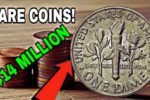Imagine picking up a Jefferson Nickel for just 3 cents at a yard sale, only to find out it’s worth thousands. Or stumbling across a Lincoln Wheat Penny in your pocket change that could fetch $144,000! These stories aren’t just dreams they’re real. A lucky Ohio man in 2018 bought a 1969-S Jefferson Nickel for pennies and sold it for $40,000. Meanwhile, rare Lincoln Wheat Pennies, especially the 1943 copper version, are still out there, potentially worth a fortune. Here’s a simple guide to these coins and how you might find your own treasure.
The Yard Sale Nickel That Struck Gold
In 2018, a man at an Ohio yard sale bought a handful of coins for pocket change, including a 1969-S Jefferson Nickel for 3 cents. When he looked closer, he noticed its crisp “Full Steps” design clear steps on Monticello’s image on the back. After appraisal, this nickel, graded MS-66 FS, sold for $40,000 at auction. Jefferson Nickels, minted since 1938 to honor Thomas Jefferson, are common, but those with “Full Steps” or rare errors can be worth big money. This find shows how a sharp eye can turn pennies into a windfall.
The Legendary 1943 Copper Wheat Penny
The Lincoln Wheat Penny, minted from 1909 to 1958, is a collector’s favorite. The 1943 copper penny is the holy grail. During World War II, pennies were made of steel to save copper, but a few copper ones were minted by mistake. Only about 20-40 of these exist, making them incredibly rare. One sold for $144,000 recently, and another fetched $1.7 million in 2010. If you find a 1943 penny that’s copper-colored and doesn’t stick to a magnet, you might be holding a life-changing coin.
Other Valuable Coins to Watch For
Besides the 1943 copper penny, other Lincoln Wheat Pennies and Jefferson Nickels can bring big bucks. For nickels, look for 1982-P or 1995-D with “Full Steps,” which can sell for $100-$300 in top condition. The 1989-P nickel with a doubled die (where the design looks doubled) might fetch $50-$200. For pennies, the 1909-S VDB (with designer Victor D. Brenner’s initials) or 1955 Doubled Die are hot picks, valued at $1,000-$2,000 even in worn condition. Errors like off-center strikes or missing mint marks also boost value.
Key Coins and Their Values
Here’s a quick look at some valuable Jefferson Nickels and Lincoln Wheat Pennies, based on auction data for high grades (MS-65 or better):
| Coin | Year | Mint Mark | Max Value (High Grade) |
|---|---|---|---|
| Jefferson Nickel | 1969 | S | $40,000 (Full Steps) |
| Jefferson Nickel | 1995 | D | $250 (Full Steps) |
| Lincoln Wheat Penny | 1943 | D | $144,000 (Copper) |
| Lincoln Wheat Penny | 1909 | S VDB | $2,000 |
| Lincoln Wheat Penny | 1955 | Doubled Die | $2,000 |
Proof coins (marked “S”) are usually less valuable unless they have errors. Always check for “Full Steps” on nickels or minting errors on pennies.
How to Spot Your Own Fortune
To find a valuable coin, check the date and mint mark (P, D, or S near the date). For pennies, use a magnet—steel 1943 pennies stick, but copper ones don’t. Weigh them too: a copper 1943 penny is about 3.11 grams, steel is 2.7 grams. For nickels, look for clear Monticello steps or doubled designs with a magnifying glass. If you think you’ve got a winner, get it graded by PCGS or NGC. Sell through eBay, coin dealers, or auction houses like Heritage Auctions for the best price. Next time you’re at a yard sale or sorting change, take a closer look you might just find a coin worth thousands!




